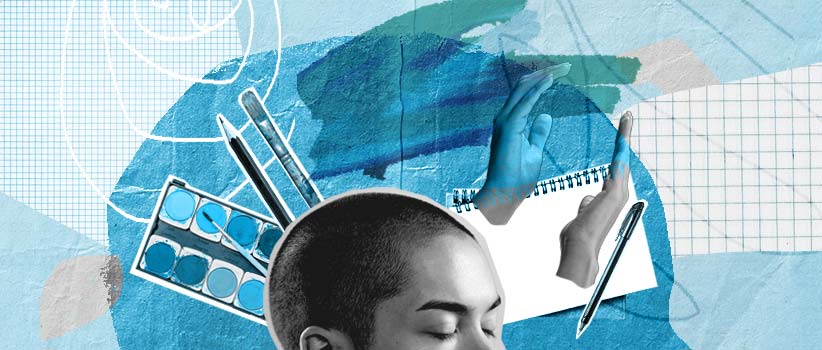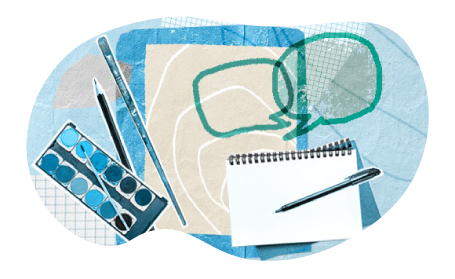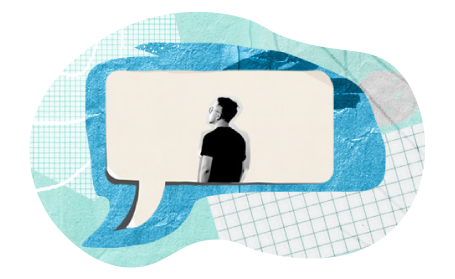How Art Therapy Can Improve Your Mental and Emotional Health

Sitting down at the kitchen table with a box of colored pencils to shade in a flower or a bird isn’t just for kids anymore. Adult coloring books have emerged as a popular activity for people trying to reduce their stress and create a sense of calm. In fact, the American Art Therapy Association (AATA) encourages the use of coloring books for recreation and self-care.
But, while artmaking does have therapeutic benefits, it’s important to distinguish it from art therapy. Taking artmaking a step further, art therapy emphasizes processing emotions with a credentialed art therapist through the experience of artmaking.
“I view my role as walking alongside each client to support their individual process and witnessing their artwork is part of that process,” said Lauren Schlenger, an art therapist from Sunstone Counseling in Virginia. “It feels so powerful to be trusted enough to sit with someone while they create and to offer an experience where clients may feel a sense of validation, relief or freedom in the art they make.”
Art therapy can be uniquely tailored to fit the specific experiences of each individual. By participating in the journey of art therapy, clients may be able to better understand themselves in a non-threatening and, sometimes, less invasive way that harnesses their creativity through engaging in emotional processing.
Jump to:
What Is Art Therapy?
The AATA defines art therapy as “an integrative mental health and human services profession that enriches lives through active art-making, creative process, applied psychological theory, and human experience within a psychotherapeutic relationship.”
This form of therapy is a regulated mental health profession facilitated by a credentialed art therapist who is specifically trained to use art interventions and the creative process to work with individuals on their needs or issues that they seek to address. While relaxing and soothing, artmaking for self-care lacks the psychological component connected to a treatment plan or set of goals the art therapist is working on with the client.
“When you’ve created an image or piece of art, you can find meaning through the artmaking process and be better able to tie that into experiences you’ve had,” Schlenger said.
According to Schlenger, key components of art therapy include:
Emotional safety: A trusting therapeutic relationship can help foster a safe and non-judgmental space for expressing and processing your physical feelings.
Emotional validation: Being able to see a visual representation of your feelings and having someone witness your vulnerability in a safe way can validate your feelings.
Emotional agency: Experiencing the creative process from start to finish can help restore a sense of agency and control over your emotions and overall mental health.
“Art therapy offers a way for someone to express aspects of themselves without relying on words,” said Gretchen Miller, an art therapist in Cleveland and AATA board member. “It transcends verbal language, and for some people that can be very non-threatening and safe because they don’t have to talk about certain experiences or emotions that are very difficult to put into words.”
How Does Art Therapy Work?
According to Schlenger, an art therapy session may include time for verbal sharing, time for more concentrated artmaking to allow clients to get into the flow of their artmaking process, and then time to verbally process what the artmaking experience was like and what it meant to them.
“My role isn’t to interpret client artwork but rather to encourage clients to share their personal experience and the meaning they made or discovered when creating,” she said. “When processing the artwork, we may also notice and explore elements of the artwork together to uncover how it connects with their thoughts, feelings and experiences.”

Components That Can Be Included in Art Therapy Sessions
AN INITIAL CHECK-IN TO BUILD RAPPORT
An art therapist may ask questions like, “What do you want to talk about in the session?,” “What have you been experiencing this week?” and “Do you have any goals for art therapy that you want to accomplish?” These questions allow the client to reflect on and understand what emotions are present.
AN OPPORTUNITY FOR PLAY AND EXPLORATION WITH DIFFERENT ART MEDIUMS
Art therapy is not constrained to drawing or painting. It can include sewing, knitting, cooking, collaging, creative writing, scrapbooking, digital artmaking, sculpting and photography. Schlenger says having openness is part of the creative process, and clients should engage with different materials that may enable them to better express themselves through art.
INITIATION OF AN ARTMAKING ACTIVITY
According to Schlenger, the art therapist can take a directive approach with clients in a session, suggesting a specific art activity, or a non-directive approach, leaving it up to the client to decide what to make. It depends on whether the client wants structure.
PROCESSING OF EMOTIONS THROUGH MINDFULNESS
Mindfulness is a critical part of art therapy. As clients are creating the art, the art therapist guides them through self-reflection and encourages self-awareness about their feelings. The process allows clients to recognize and identify their feelings, sit with and absorb them, and eventually develop new insight based on observing what they felt.
ACTIVE DISCUSSION WITH THE THERAPIST
A session does not have to be silent during the artmaking process. The importance lies in processing the emotions and connecting that experience to your art. In fact, Schlenger says that talking through emotions out loud throughout the artmaking process can help to increase the comfort within the session.
The goal of the session is to reflect on and understand the art that they have made in order to better understand and manage feelings moving forward.
Why Art Therapy Works
“It can be scary to explore issues about yourself in real life outside the art room, so art therapy offers the opportunity to safely practice things like taking risks through your art,” Miller said.
The experience of art therapy engages clients in the decision-making process, prompting them with questions like what to draw or which colors to use, which in turn enhances their ability to problem solve and apply that knowledge to real life. It can also help clients think through new possibilities and ways of addressing problems, helping them see a future beyond the present moment, which may be clouded by negative emotions.
According to a 2020 article on expressive arts therapy in Psychology Today, the practice can help clients dissociate from anxiety, trauma and fear, supporting emotional self-regulation and better enabling them to respond to stress. Miller teaches her clients specific tools or strategies in the artmaking process that help regulate and express emotions by taking what’s internal and making it visible.
“It’s about taking those emotions building up inside someone and being able to put that out there, which in turn empowers clients to explore that more or do something with that emotion in a way that will lead to growth or resolution,” Miller said.
According to Schlenger, art therapy is also useful in uncovering hidden traumas.
“Sometimes what’s expressed in the art can bring up unconscious feelings,” she said, which clients may need help working up the courage to talk through. “It’s not just the process of creating and talking about it but the process of creating by itself.”

Questions To Consider Before Engaging in Art Therapy
How do you prefer to express your experiences, feelings and thoughts? Miller emphasized that it’s important for people to consider whether it’s easier to express themselves through images or words.
How do you respond to creating art? If you observe yourself experiencing an intense reaction, either negative or positive, during the process of creating art, consider tapping into that reaction with an art therapist.
Do you have a history of pre-verbal trauma? The sensory-based component of art therapy can help you express feelings without words, so you don’t have to rely on speaking and using language if that is too difficult or triggering.
For those who are nervous about seeking art therapy treatment, creating art can still be a form of self-care. Taking a moment for yourself to get out of your head and engage in something that gives you enjoyment can help reduce stress and enhance emotional regulation, Miller pointed out.
“Whether your mind is anxiously wandering about the future or regretfully ruminating on things in the past you can’t change, art is there to slow you down,” she said. “It helps you practice being content with and present in the moment, which demonstrates to you what that feels like and allows you to be able to transfer that to other situations in order to cope.
For those using artmaking as a means to relax, Miller suggests engaging in rhythmic activities, such as doodling, knitting, crocheting or meditative drawing.
“That repetitive pattern of doing that over and over again can help calm your thoughts and re-establish a connection with yourself and your own self-care,” she said.
Engaging Adolescents in Art Therapy
One benefit of art therapy is that clients do not need to be an artist to reap the benefits of artmaking in a therapeutic environment. This can connect well with teens, who are still developing mentally and physically.
“Developmentally, teens are trying to make sense of their own identity and values,” Miller said. “They’re thinking about how they’re feeling in their relationships with peers, family and the world.”
One benefit of art therapy is that clients do not need to be an artist to reap the benefits of artmaking in a therapeutic environment.
According to a study on art therapy for adolescents in the Western Journal of Medicine, teens and young adults can benefit from art therapy because it’s a non-threatening way to express their inner thoughts and still receive support. Distressed teens may not trust adults in their lives to help them. In cases of abuse, for example, teens may feel embarrassed to reveal details or fear putting themselves at risk. They can use art to express their emotions and feelings visually.
“When I work with teenage clients, there can be that discomfort of going to therapy, but I try to normalize it and talk about it as a healthy way to express yourself,” Schlenger said.
From Miller’s experience, art therapy group work for teens can be highly beneficial because they’re learning how to relate with peers their age. Being in a group with other teens who are also experiencing similar issues can help to create a sense of belonging and support while alleviating isolation.
Miller believes that art therapy can help teens achieve a sense of self-awareness and clarity around their strengths, values and beliefs, which better positions them to understand their struggles and cope.
“Creativity is a huge strength of teens at this time, so they can really tap into the art therapy session with that and explore different things happening in their lives,” Miller said.
Art Therapy Resources
American Art Therapy Association: An organization that advocates for accessible art therapy and advances art therapy as a regulated mental health profession.
American Art Therapy Association Art Therapist Locator: This is a geographical directory of credentialed art therapists.
Art Therapy Credentials Board: Provides additional information on credentials.
International Expressive Arts Therapy Association: An organization that supports art therapists’ work in an inclusive and culturally diverse way.
Art Therapy Without Borders: An organization that promotes art therapy and art therapy research in mental health, educates others on art therapy and develops art therapy programs.
The Art Therapy Alliance: An organization that uses social media to promote and advance art therapy and the work of art therapists and seeks to build community.
Remote Art Therapy Resources: A list of art therapy resources during coronavirus provided by Children’s National Hospital in response to the pandemic.
Art Therapy in Action: Adolescents, AATA: An informational video on the beneficial relationship that adolescents can have with art therapy.
Thirsty For Art: An art therapist who posts resources on art therapy on Instagram and YouTube.
Self-Exercises: These videos separate self-guided art therapy exercises by depression, anxiety, stress management and emotional pain/healing.
5 Tips for When You Can’t Draw Your Feelings: A video on how to work around a creative block.
Resources Folder: List of resources such as podcasts, books and groups about art therapy and art therapy education.
Information on OnlineCounselingPrograms.com is not intended to be a substitute for professional counseling advice. Always consult qualified professionals with any questions you may have about mental and behavioral health-related issues.

